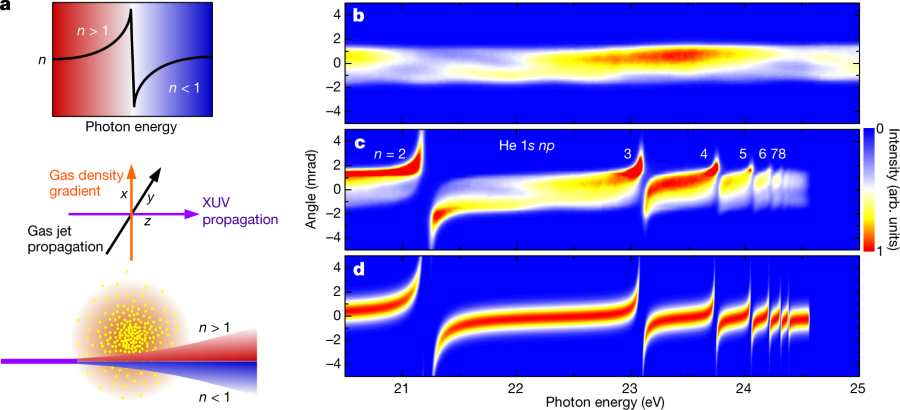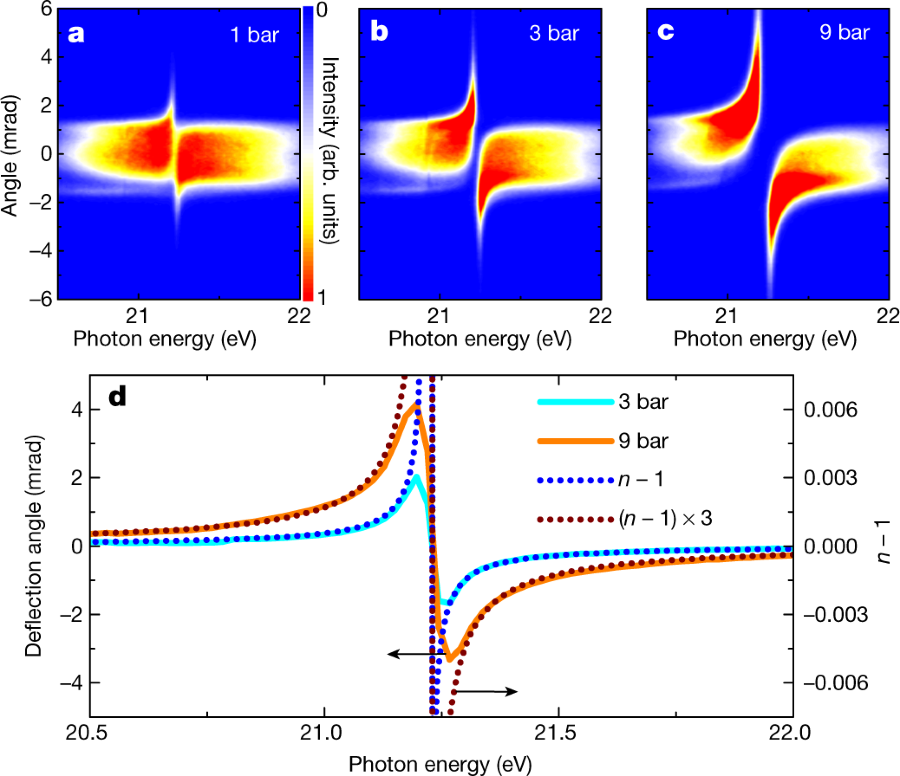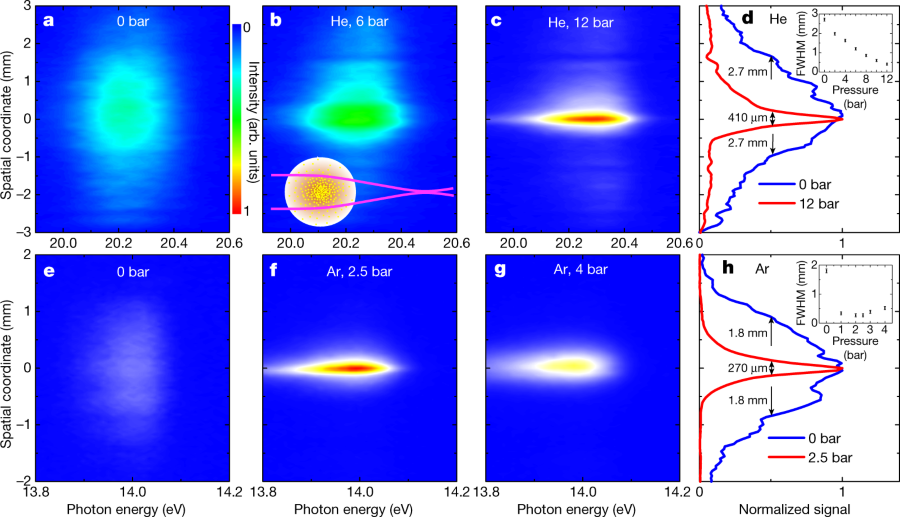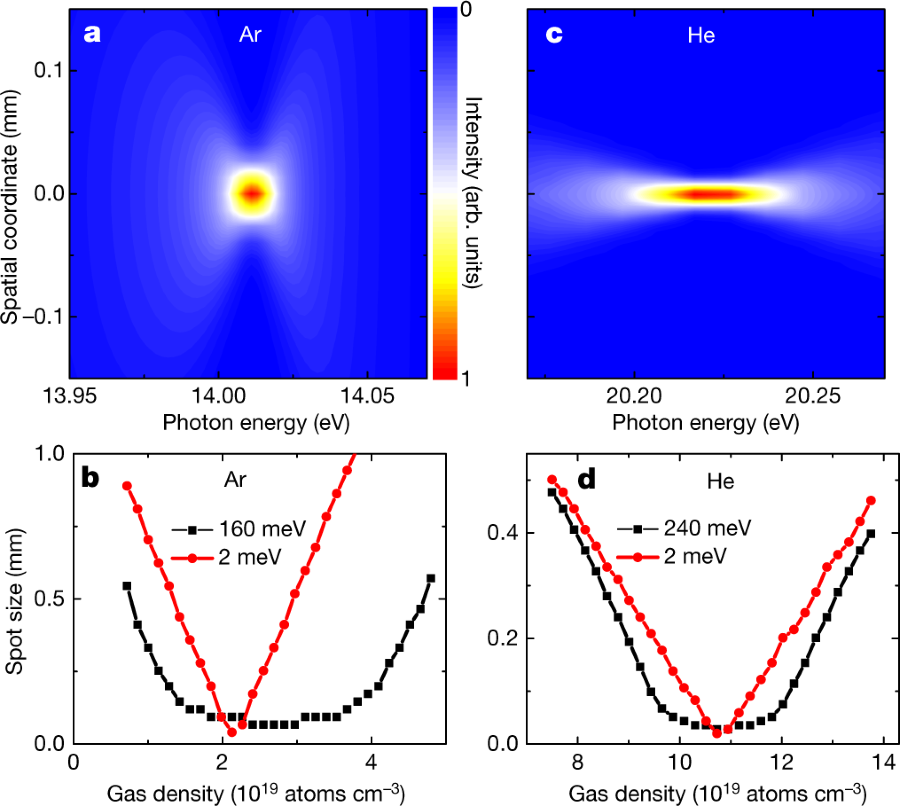Refractive Lens for Extreme UV Radiation Discovered.
The paper I'll discuss in this post is this one: Extreme-ultraviolet refractive optics| Extreme-ultraviolet refractive optics (L. Drescher, O. Kornilov, T. Witting, G. Reitsma, N. Monserud, A. Rouzée, J. Mikosch, M. J. J. Vrakking & B. Schütte, Nature 564, 91–94 (2018) )
Lenses for focusing extreme UV light - just short of x-rays in energy - do not exist. One can imagine many applications for this capability, for instance in materials etching, welding and other processing, spectroscopic investigations of the structure of matter, cancer and other surgeries (should the focusing be refined enough - hard to see here since the lenses are gases) and regrettably, as no discovery is free of possible sinister use, weapons systems.
The introductory text tells the story better than I can:
Refraction of light is omnipresent in nature, where it forms the basis for the functionality of the human eye and the observation of a rainbow. It is exploited in many applications in the visible, infrared and ultraviolet spectral regions. For instance, refractive errors of the eye are corrected by glasses or contact lenses, and optical microscopes enable the magnification of small objects or structures. In the context of laser physics, refractive lenses are extensively used to focus or (de-)magnify laser beams. Dispersion and deflection of light by optical prisms is used to compress or stretch ultrashort laser pulses.
When Röntgen discovered X-rays in 1895, he attempted refraction experiments using prisms and lenses8. Because he observed no significant deflection of the X-rays, he concluded that refractive lenses were not suitable for focusing X-ray radiation. A century later, a compound refractive lens consisting of a lens array was nevertheless developed for the hard X-ray regime, assisted by the comparably low absorption in this spectral region. Compound refractive lenses are used to focus X-rays emitted from modern synchrotron9 and free-electron laser facilities10,11. They have been applied for hard X-ray microscopy12, for X-ray nanofocusing13 and for the investigation of crystal scattering14, as well as for coherent diffractive imaging of nanoscale samples15.
Refractive elements have so far been missing in the extreme-ultraviolet (XUV) range but are highly desirable. For instance, refractive lenses could be used to focus XUV pulses without changing the propagation direction, thereby providing considerable flexibility. The use of specially designed microscopic refractive lenses has been proposed16,17. However, the need to use very thin lenses with a sophisticated design, owing to the strong absorption of XUV radiation, makes practical implementation challenging.
Here, we demonstrate that control over the refraction of XUV pulses can be achieved by using gases instead of solids. We exploit the fact that close to atomic resonances, the refractive index n has a dispersive lineshape, as depicted in the top part of Fig. 1a.
The authors utilize gas jets to focus the XUV beams using density gradients in the gas pulses. Since (in this case) the gases are monoatomic noble gases, they cannot be damaged by the energy that is contained in extreme UV radiation, as is the case with solid phase lenses.
If interested, take a look at the pictures.
Figure 1:

The caption:
a, Top, dispersive lineshape of the refractive index in the vicinity of an atomic resonance. Spectral components at photon energies below the resonance (n > 1) are indicated in red, components at energies above the resonance (n?<?1) in blue. Middle, experimental configuration, showing an XUV pulse (violet arrow) that crosses a gas jet (black arrow), which has a density gradient in the vertical direction (orange arrow), at right angles. Bottom, deflection of an XUV pulse propagating below the centre of the gas jet. b, Angle-resolved spectrum of a broadband HHG pulse measured in the absence of the gas jet. The angular divergence of the XUV beam in the vertical direction is reflected in the spatial distribution along the vertical axis. arb. units, arbitrary units. c, The same spectrum after propagation at a distance of 0.3 mm below the centre of a dense He gas jet (generated using a backing pressure of 10 bar) shows clear signatures of refraction. Spectral components with photon energies below the 1s np resonances of He are deflected upwards, whereas spectral components above these resonances are deflected downwards. The deflection angles are largest close to the 1s 2p resonance and decrease for higher resonances, owing to the decreasing oscillator strengths. Above the ionization potential of He (at 24.58 eV), the XUV radiation is strongly absorbed. Owing to ageing effects, the sensitivity of the detector was reduced in regions where the undisturbed HHG spectrum is recorded (as in b) compared with regions where the deflected XUV radiation is observed. This makes the deflected XUV radiation appear more intense. d, Simulation of the XUV refraction in an inhomogeneous He gas jet, taking into account 1s np resonances with n?=?2,?3,?…,?8. The simulation indicates that for a backing pressure of 10 bar, a gas jet with a peak density of 9?×?10^19 atoms cm?3 (corresponding to a pressure of 3.7 bar at 300 K) was achieved in the interaction zone.
Figure 2:

The caption:
a–c, Angle-resolved XUV spectra after propagation at a distance of 0.3 mm below the centre of a He gas jet, for backing pressures of 1 bar (a), 3 bar (b) and 9 bar (c). d, The average deflection angle as a function of the photon energy for backing pressures of 3 bar (corresponding to a peak pressure in the interaction zone of about 1 bar; cyan solid curve) and 9 bar (orange solid curve). Here the vertical scale on the left axis applies, as indicated by the upper arrow. For comparison, the calculated refractivity (that is, n ? 1) at standard temperature (273.15 K) and standard pressure (1 bar) is plotted on top of the deflection results (blue dotted curve). The vertical scale on the right axis applies, as indicated by the lower arrow. Note that the calculated refractivity is proportional to the pressure. The brown dotted curve shows the calculated refractivity multiplied by a factor of 3.
Image 3 (focused XUV radiation):

a, Spatially resolved spectrum of unfocused XUV radiation at 20.2 eV (corresponding to the 13th harmonic). b, c, The divergence of this harmonic is altered after propagation through a He gas jet (see inset of d), as shown for backing pressures of 6 bar (b) and 12 bar (c). d, Comparison of the vertical beam profiles using backing pressures of 0 bar (blue curve) and 12 bar (red curve). The inset shows the pressure-dependent spot size, where the error bars reflect the uncertainties in determining the spot sizes. e, Spatially resolved spectrum of radiation at 14.0 eV (corresponding to the ninth harmonic), which is close to the 3d and 5s resonances of Ar. f, Focusing of this harmonic is achieved by an Ar gas jet at a backing pressure of 2.5 bar. g, When further increasing the backing pressure to 4 bar, an increasing beam size is observed, because the Ar lens focuses the XUV beam between the gas jet and the detector. h, The vertical beam profiles for Ar backing pressures of 0 bar (blue curve) and 2.5 bar (red curve). The inset shows the pressure-dependent spot size, where the error bars reflect the uncertainties in determining the spot sizes.
Fig. 4: Simulation of the XUV focus:

The caption:
a, Simulated focus in the vertical direction as a function of the photon energy following propagation of an XUV pulse at 14.0 eV (1.9 mm FWHM diameter) through an Ar gas jet with a peak density of 2.2?×?1019 atoms cm?3 (corresponding to a pressure of 0.9 bar at 300 K). Because of chromatic aberration, the XUV spot size depends on the photon energy. b, Spot size as a function of the Ar gas density for XUV pulses with a bandwidth of 160 meV (black curve) and 2 meV (red curve), showing minimal spot sizes of 74 ?m and 40 ?m, respectively. c, The chromatic aberration is reduced for photon energies that are further away from the resonance. This is shown for the example of an XUV pulse at 20.2 eV (2.4 mm FWHM diameter) that propagates through a He gas jet with a peak density of 1.1?×?1020 atoms cm?3 (corresponding to a pressure of 4.3 bar at 300 K). d, Spot size as a function of He gas density for XUV pulses with a bandwidth of 240 meV (black curve) and 2 meV (red curve), which exhibit minimal spot sizes of 28 ?m and 20 ?m.
The authors conclude:
In conclusion, we have presented a method to deflect and focus XUV pulses by using the inhomogeneity of a gas jet placed in the way of an XUV beam. Our results enable the transfer of concepts based on refractive optics that are widely used in other spectral regions to the XUV regime, including microscopy, nanofocusing and the compression of ultrashort pulses. XUV gas-based lenses have several advantages, including their high transmission, deformability and tunability (by varying the gas composition, the gas pressure and the gas jet geometry)...
...Refractive XUV gas-phase lenses can be designed for photon energies between 10 eV and 24 eV by carefully selecting appropriate atoms or molecules for different photon energies. In the future, this range might be extended to higher photon energies by developing lenses that exploit refraction in an inhomogeneous plasma consisting of highly charged ions and electrons.
Esoteric, but interesting.
Have a pleasant day tomorrow.



